Decline in Seasonal Snow during a Projected 20-Year Dry Spell
Abstract
:1. Introduction
2. Data
2.1. California’s Drought of the Future
2.2. Hydroclimate Projections
2.3. Wildfire Projections
3. Methods
3.1. The Snow Seasonality Metric
- Seasonal snowpacks → ephemeral snowpacks: The transition from a seasonal snowpack to an ephemeral snowpack represents a notable change in the properties and role of the snowpack on the landscape. This transition indicates that on average, a 60-day period of continuous snowpack no longer occurs. Historically, many seasonal Pacific Southwest snowpacks can transition to ephemeral during dry (sunny and warm) and/or rainier-than-normal winter seasons [33].
- No change: SSM values remain the same between the two periods.
- Less seasonal snowpacks: Snowpacks that become less seasonal are expected to experience more days of ephemeral snow, but not enough to remove the 60 day continuous snowpack presence constraint (shifting them into the first category, seasonal snowpacks → ephemeral snowpacks). The most seasonal snowpack has an SSM equal to 1, indicating once snow begins falling for a winter season, it accumulates continuous before peaking and beginning its ablation back to snow-free conditions. As a result of ephemeral snow days before beginning the seasonal cycle of accumulation or following the melt-out of seasonal snow, the SSM will often be less than 1. The increasing fraction of fall or spring precipitation falling as rain instead of snow [45] and increasing dry day frequencies [46] are two ways during the shoulder seasons to create more ephemeral snowpacks as less snow accumulates and more opportunities for melt occurs.
- More seasonal snowpacks: For a seasonal snowpack to become more seasonal in a warmer and drier world, there must be a decline in the number of ephemeral snow days, driving the value produced by Equation (1) to approach 1, likely to occur only in high elevations where snow is not transitioning to rain during the core winter season. The loss of high elevation ephemeral snow days is likely the result of winter or spring drying (enhanced seasonality), an additional expectation of California climate change [47,48], as temperatures during precipitation more frequently remain cold enough to produce snow.
3.2. Other Projections
4. Results
4.1. Characteristics of the Mid-Century Dry Spell
4.2. Effect of the Mid-Century Dry Spell on Snow Seasonality
4.3. Wildfire Projections
4.4. Changes in Streamflow
5. Discussion
6. Conclusions
Author Contributions
Funding
Institutional Review Board Statement
Informed Consent Statement
Data Availability Statement
Acknowledgments
Conflicts of Interest
Abbreviations
| ET | Evapotranspiration |
| MCDS | Mid-Century Dry Spell |
| LOCA | LOcally Constructed Analogs |
| VIC | Variable Infiltration-Capacity Model |
| CMIP5 | Fifth Coupled Model Intercomparison Project |
| SWE | Snow Water Equivalent |
References
- Huss, M.; Bookhagen, B.; Huggel, C.; Jacobsen, D.; Bradley, R.; Clague, J.; Vuille, M.; Buytaert, W.; Cayan, D.; Greenwood, G.; et al. Toward mountains without permanent snow and ice. Earth’s Future 2017, 5, 418–435. [Google Scholar] [CrossRef]
- Viviroli, D.; Dürr, H.H.; Messerli, B.; Meybeck, M.; Weingartner, R. Mountains of the world, water towers for humanity: Typology, mapping, and global significance. Water Resour. Res. 2007, 43, W07447. [Google Scholar] [CrossRef]
- Contosta, A.R.; Casson, N.J.; Garlick, S.; Nelson, S.J.; Ayres, M.P.; Burakowski, E.A.; Campbell, J.; Creed, I.; Eimers, C.; Evans, C.; et al. Northern forest winters have lost cold, snowy conditions that are important for ecosystems and human communities. Ecol. Appl. 2019, 29, e01974. [Google Scholar] [CrossRef] [PubMed]
- Hagenstad, M.; Burakowski, E.; Hill, R. The Economic Contributions of Winter Sports in a Changing Climate; Technical Report; Protect Our Winters: Boulder, CO, USA, 2018. [Google Scholar]
- Hatchett, B.J.; Eisen, H.G. Brief Communication: Early season snowpack loss and implications for oversnow vehicle recreation travel planning. Cryosphere 2019, 13, 21–28. [Google Scholar] [CrossRef]
- Crowley, N.; Doolittle, C.; King, J.; Mace, R.; Seifer, J. Drought and Outdoor Recreation: Impacts, Adaptation Strategies, and Information Gaps in the Intermountain West; Technical Report; University of Colorado: Boulder, CO, USA, 2019. [Google Scholar]
- Rhoades, A.M.; Jones, A.D.; Ullrich, P.A. The Changing Character of the California Sierra Nevada as a Natural Reservoir. Geophys. Res. Lett. 2018, 45, 13,008–13,019. [Google Scholar] [CrossRef]
- Siirila-Woodburn, E.; Rhoades, A.; Hatchett, B.; Huning, L.; Szinai, J.; Tague, C.; Nico, P.; Feldman, D.; Jones, A.; Collins, W.; et al. Evidence of a low-to-no snow future and its impacts on water resources in the western United States. Nat. Rev. Earth Environ. 2021, 2, 800–819. [Google Scholar] [CrossRef]
- Rhoades, A.; Hatchett, B.; Risser, M.; Collins, B.; Bambach, N.; Huning, L.; McCrary, R.; Siirila-Woodburn, E.; Ullrich, P.; Wehner, M.; et al. Asymmetric Emergence of Low-to-No Snow in the Midlatitudes of the American Cordillera; Creative Commons: Mountain View, CA, USA, 2021. [Google Scholar] [CrossRef]
- Sturm, M.; Goldstein, M.A.; Parr, C. Water and life from snow: A trillion dollar science question. Water Resour. Res. 2017, 53, 3534–3544. [Google Scholar] [CrossRef]
- Herbold, B.; Bush, E.; Castillo, G.; Colombano, D.; Hartman, R.; Lehman, P.; Mahardja, B.; Sommer, T. Climate Change Impacts on San Francisco Estuary Aquatic Ecosystems: A Review. San Fr. Estuary Watershed Sci. 2022, 20. [Google Scholar] [CrossRef]
- Livneh, B.; Badger, A.M. Drought less predictable under declining future snowpack. Nat. Clim. Change 2020, 10, 452–458. [Google Scholar] [CrossRef]
- Huggins, X.; Gleeson, T.; Kummu, M.; Zipper, S.C.; Wada, Y.; Troy, T.J.; Famiglietti, J.S. Hotspots for social and ecological impacts from freshwater stress and storage loss. Nat. Commun. 2022, 13, 439. [Google Scholar] [CrossRef]
- Cayan, D.R.; Das, T.; Pierce, D.W.; Barnett, T.P.; Tyree, M.; Gershunov, A. Future dryness in the southwest US and the hydrology of the early 21st century drought. Proc. Natl. Acad. Sci. USA 2010, 107, 21271–21276. [Google Scholar] [CrossRef] [PubMed]
- Overpeck, J.T.; Udall, B. Climate change and the aridification of North America. Proc. Natl. Acad. Sci. USA 2020, 117, 11856–11858. [Google Scholar] [CrossRef] [PubMed]
- Milly, P.C.D.; Dunne, K.A. Colorado River flow dwindles as warming-driven loss of reflective snow energizes evaporation. Science 2020, 367, 1252–1255. [Google Scholar] [CrossRef]
- Williams, A.P.; Cook, B.I.; Smerdon, J.E. Rapid intensification of the emerging southwestern North American megadrought in 2020–2021. Nat. Clim. Change 2022, 12, 232–234. [Google Scholar] [CrossRef]
- Hatchett, B.J.; Boyle, D.P.; Putnam, A.E.; Bassett, S.D. Placing the 2012-2015 California-Nevada drought into a paleoclimatic context: Insights from Walker Lake, California-Nevada, USA. Geophys. Res. Lett. 2015, 42, 8632–8640. [Google Scholar] [CrossRef]
- Milly, P.C.D.; Betancourt, J.; Falkenmark, M.; Hirsch, R.M.; Kundzewicz, Z.W.; Lettenmaier, D.P.; Stouffer, R.J. Stationarity Is Dead: Whither Water Management? Science 2008, 319, 573–574. [Google Scholar] [CrossRef]
- Cook, B.I.; Seager, R.; Miller, R.L. On the Causes and Dynamics of the Early Twentieth-Century North American Pluvial. J. Clim. 2011, 24, 5043–5060. [Google Scholar] [CrossRef]
- Wheeler, K.G.; Udall, B.; Wang, J.; Kuhn, E.; Salehabadi, H.; Schmidt, J.C. What will it take to stabilize the Colorado River? Science 2022, 377, 373–375. [Google Scholar] [CrossRef] [PubMed]
- Tripati, A.; Shepherd, M.; Morris, V.; Andrade, K.; Whyte, K.P.; David-Chavez, D.M.; Trujillo-Falcón, J.E.; Hunter, B.; Hence, D.; Carlis, D.; et al. Centering Equity in the Nation’s Weather, Water and Climate Services. EarthArXiv 2022. [Google Scholar] [CrossRef]
- Alizadeh, M.R.; Abatzoglou, J.T.; Luce, C.H.; Adamowski, J.F.; Farid, A.; Sadegh, M. Warming enabled upslope advance in western US forest fires. Proc. Natl. Acad. Sci. USA 2021, 118, e2009717118. [Google Scholar] [CrossRef]
- Guirguis, K.; Gershunov, A.; Hatchett, B.; Shulgina, T.; DeFlorio, M.; Subramanian, A.; Guzman-Morales, J.; Aguilera, R.; Clemesha, R.; Corringham, T.; et al. Weather Patterns Driving Atmospheric Rivers, Santa Ana Winds, Floods, and Wildfires During California Winters Provide Evidence for Increasing Fire Risk. Clim. Dyn. 2022. [Google Scholar] [CrossRef]
- Garreaud, R.D.; Boisier, J.P.; Rondanelli, R.; Montecinos, A.; Sepúlveda, H.H.; Veloso-Aguila, D. The Central Chile Mega Drought (2010–2018): A climate dynamics perspective. Int. J. Climatol. 2020, 40, 421–439. [Google Scholar] [CrossRef]
- Muñoz, A.A.; Klock-Barría, K.; Alvarez-Garreton, C.; Aguilera-Betti, I.; Gonzalez-Reyes, A.; Lastra, J.A.; Chávez, R.O.; Barría, P.; Christie, D.; Rojas-Badilla, M.; et al. Water Crisis in Petorca Basin, Chile: The Combined Effects of a Mega-Drought and Water Management. Water 2020, 12, 648. [Google Scholar] [CrossRef]
- Sturm, M.; Holmgren, J.; Liston, G.E. A Seasonal Snow Cover Classification System for Local to Global Applications. J. Clim. 1995, 8, 1261–1283. [Google Scholar] [CrossRef]
- Trujillo, E.; Molotch, N.P. Snowpack regimes of the Western United States. Water Resour. Res. 2014, 50, 5611–5623. [Google Scholar] [CrossRef]
- Petersky, R.; Harpold, A. Now you see it, now you do not: A case study of ephemeral snowpacks and soil moisture response in the Great Basin, USA. Hydrol. Earth Syst. Sci. 2018, 22, 4891–4906. [Google Scholar] [CrossRef]
- Rhoades, A.M.; Ullrich, P.A.; Zarzycki, C.M. Projecting 21st century snowpack trends in western USA mountains using variable-resolution CESM. Clim. Dyn. 2018, 50, 261–288. [Google Scholar] [CrossRef]
- Nolin, A.W.; Sproles, E.A.; Rupp, D.E.; Crumley, R.L.; Webb, M.J.; Palomaki, R.T.; Mar, E. New snow metrics for a warming world. Hydrol. Process. 2021, 35, e14262. [Google Scholar] [CrossRef]
- Zeng, X.; Broxton, P.; Dawson, N. Snowpack Change From 1982 to 2016 over Conterminous United States. Geophys. Res. Lett. 2018, 45, 12,940–12,947. [Google Scholar] [CrossRef]
- Hatchett, B.J. Seasonal and Ephemeral Snowpacks of the Conterminous United States. Hydrology 2021, 8, 32. [Google Scholar] [CrossRef]
- Nolin, A.W.; Daly, C. Mapping “at Risk” Snow in the Pacific Northwest. J. Hydrometeorol. 2006, 7, 1164–1171. [Google Scholar] [CrossRef]
- Scott, D. Global Environmental Change and Mountain Tourism. In Tourism and Global Environmental Change; Gössling, S., Hall, C.M., Eds.; Routledge: London, UK, 2006; Chapter 3; pp. 54–75. [Google Scholar] [CrossRef]
- Sterle, K.; Hatchett, B.J.; Singletary, L.; Pohll, G. Hydroclimate Variability in Snow-Fed River Systems: Local Water Managers’ Perspectives on Adapting to the New Normal. Bull. Am. Meteorol. Soc. 2019, 100, 1031–1048. [Google Scholar] [CrossRef]
- Marshall, A.M.; Foard, M.; Cooper, C.M.; Edwards, P.; Hirsch, S.L.; Russell, M.; Link, T.E. Climate change literature and information gaps in mountainous headwaters of the Columbia River Basin. Reg. Environ. Change 2020, 20, 134. [Google Scholar] [CrossRef]
- Immerzeel, W.W.; Lutz, A.F.; Andrade, M.; Bahl, A.; Biemans, H.; Bolch, T.; Hyde, S.; Brumby, S.; Davies, B.J.; Elmore, A.C.; et al. Importance and vulnerability of the world’s water towers. Nature 2020, 577, 364–369. [Google Scholar] [CrossRef]
- Pierce, D.W.; Kalansky, J.F.; Cayan, D.R. Climate, Drought, and Sea Level Rise Scenarios for the Fourth California Climate Assessment. In California’s Fourth Climate Change Assessment; Technical Report CNRA-CEC-2018-006; California Energy Commission: Sacramento, CA, USA, 2018. [Google Scholar]
- California Department of Water Resources (DWR); Climate Change Technical Advisory Group (CCTAG). Perspectives and Guidance for Climate Change Analysis; Technical Report; California Department of Water Resources: Sacramento, CA, USA, 2015.
- Livneh, B.; Bohn, T.J.; Pierce, D.W.; Munoz-Arriola, F.; Nijssen, B.; Vose, R.; Cayan, D.R.; Brekke, L. A spatially comprehensive, hydrometeorological data set for Mexico, the U.S., and Southern Canada 1950–2013. Sci. Data 2015, 2, 150042. [Google Scholar] [CrossRef]
- Liang, X.; Lettenmaier, D.P.; Wood, E.F.; Burges, S.J. A simple hydrologically based model of land surface water and energy fluxes for general circulation models. J. Geophys. Res. Atmos. 1994, 99, 14415–14428. [Google Scholar] [CrossRef]
- Westerling, A.L. Wildfire Simulations for California’s Fourth Climate Change Assessment: Projecting Changes in ExtremeWildfire Events with a Warming Climate. In California’s Fourth Climate Change Assessment; Technical Report CCCA4-CEC-2018-014; California Energy Commission: Sacramento, CA, USA, 2018. [Google Scholar]
- Balch, J.K.; Bradley, B.A.; Abatzoglou, J.T.; Nagy, R.C.; Fusco, E.J.; Mahood, A.L. Human-started wildfires expand the fire niche across the United States. Proc. Natl. Acad. Sci. USA 2017, 114, 2946–2951. [Google Scholar] [CrossRef]
- Lynn, E.; Cuthbertson, A.; He, M.; Vasquez, J.P.; Anderson, M.; Abatzoglou, J.T.; Hatchett, B.J. Technical note: Precipitation-phase partitioning at landscape scales to regional scales. Hydrol. Earth Syst. Sci. 2020, 24, 5317–5328. [Google Scholar] [CrossRef]
- Polade, S.D.; Pierce, D.W.; Cayan, D.R.; Gershunov, A.; Dettinger, M.D. The key role of dry days in changing regional climate and precipitation regimes. Sci. Rep. 2014, 4, 4364. [Google Scholar] [CrossRef]
- Gershunov, A.; Shulgina, T.; Clemesha, R.E.; Guirguis, K.; Pierce, D.W.; Dettinger, M.D.; Lavers, D.A.; Cayan, D.R.; Polade, S.D.; Kalansky, J.; et al. Precipitation regime change in Western North America: The role of atmospheric rivers. Sci. Rep. 2019, 9, 9944. [Google Scholar] [CrossRef]
- Luković, J.; Chiang, J.C.H.; Blagojević, D.; Sekulić, A. A Later Onset of the Rainy Season in California. Geophys. Res. Lett. 2021, 48, e2020GL090350. [Google Scholar] [CrossRef]
- Hatchett, B.J.; McEvoy, D.J. Exploring the Origins of Snow Drought in the Northern Sierra Nevada, California. Earth Interact. 2018, 22, 1–13. [Google Scholar] [CrossRef]
- McEvoy, D.J.; Pierce, D.W.; Kalansky, J.F.; Cayan, D.R.; Abatzoglou, J.T. Projected Changes in Reference Evapotranspiration in California and Nevada: Implications for Drought and Wildland Fire Danger. Earth’s Future 2020, 8, e2020EF001736. [Google Scholar] [CrossRef]
- Klos, P.Z.; Link, T.E.; Abatzoglou, J.T. Extent of the rain-snow transition zone in the western U.S. under historic and projected climate. Geophys. Res. Lett. 2014, 41, 4560–4568. [Google Scholar] [CrossRef]
- Prein, A.F.; Heymsfield, A.J. Increased melting level height impacts surface precipitation phase and intensity. Nat. Clim. Change 2020, 10, 771–776. [Google Scholar] [CrossRef]
- Harpold, A.A.; Brooks, P.D. Humidity determines snowpack ablation under a warming climate. Proc. Natl. Acad. Sci. USA 2018, 115, 1215–1220. [Google Scholar] [CrossRef]
- Ullrich, P.A.; Xu, Z.; Rhoades, A.; Dettinger, M.; Mount, J.; Jones, A.; Vahmani, P. California’s Drought of the Future: A Midcentury Recreation of the Exceptional Conditions of 2012–2017. Earth’s Future 2018, 6, 1568–1587. [Google Scholar] [CrossRef]
- Brandt, W.T.; Haleakala, K.; Hatchett, B.J.; Pan, M. A Review of the Hydrologic Response Mechanisms during Mountain Rain-on-Snow. Front. Earth Sci. 2022, 10, 791760. [Google Scholar] [CrossRef]
- Hatchett, B.J.; Cao, Q.; Dawson, P.B.; Ellis, C.J.; Hecht, C.W.; Kawzenuk, B.; Lancaster, J.T.; Osborne, T.C.; Wilson, A.M.; Anderson, M.L.; et al. Observations of an Extreme Atmospheric River Storm with a Diverse Sensor Network. Earth Space Sci. 2020, 7, e2020EA001129. [Google Scholar] [CrossRef]
- Hatchett, B.J.; Rhoades, A.M.; McEvoy, D.J. Monitoring the Daily Evolution and Extent of Snow Drought. Nat. Hazards Earth Syst. Sci. 2021, 22, 869–890. [Google Scholar] [CrossRef]
- He, M.; Whitin, B.; Hartman, R.; Henkel, A.; Fickenschers, P.; Staggs, S.; Morin, A.; Imgarten, M.; Haynes, A.; Russo, M. Verification of Ensemble Water Supply Forecasts for Sierra Nevada Watersheds. Hydrology 2016, 3, 35. [Google Scholar] [CrossRef]
- Heggli, A.; Hatchett, B.; Schwartz, A.; Bardsley, T.; Hand, E. Toward snowpack runoff decision support. iScience 2022, 25, 104240. [Google Scholar] [CrossRef]
- Delaney, C.J.; Hartman, R.K.; Mendoza, J.; Dettinger, M.; Delle Monache, L.; Jasperse, J.; Ralph, F.M.; Talbot, C.; Brown, J.; Reynolds, D.; et al. Forecast Informed Reservoir Operations Using Ensemble Streamflow Predictions for a Multipurpose Reservoir in Northern California. Water Resour. Res. 2020, 56, e2019WR026604. [Google Scholar] [CrossRef]
- Scanlon, B.R.; Reedy, R.C.; Faunt, C.C.; Pool, D.; Uhlman, K. Enhancing drought resilience with conjunctive use and managed aquifer recharge in California and Arizona. Environ. Res. Lett. 2016, 11, 035013. [Google Scholar] [CrossRef]
- Dillon, P.; Stuyfzand, P.; Grischek, T.; Lluria, M.; Pyne, R.; Jain, R.; Bear, J.; Schwarz, J.; Wang, W.; Fernandez, E.; et al. Sixty years of global progress in managed aquifer recharge. Hydrogeol. J. 2019, 27, 1–30. [Google Scholar] [CrossRef]
- Rhoades, A.M.; Jones, A.D.; Srivastava, A.; Huang, H.; O’Brien, T.A.; Patricola, C.M.; Ullrich, P.A.; Wehner, M.; Zhou, Y. The Shifting Scales of Western U.S. Landfalling Atmospheric Rivers under Climate Change. Geophys. Res. Lett. 2020, 47, e2020GL089096. [Google Scholar] [CrossRef]
- Payne, A.E.; Demory, M.E.; Leung, L.R.; Ramos, A.M.; Shields, C.A.; Rutz, J.J.; Siler, N.; Villarini, G.; Hall, A.; Ralph, F.M. Responses and impacts of atmospheric rivers to climate change. Nat. Rev. Earth Environ. 2020, 1, 143–157. [Google Scholar] [CrossRef]
- Rhoades, A.M.; Risser, M.D.; Stone, D.A.; Wehner, M.F.; Jones, A.D. Implications of warming on western United States landfalling atmospheric rivers and their flood damages. Weather Clim. Extrem. 2021, 32, 100326. [Google Scholar] [CrossRef]
- Hatchett, B.J.; Daudert, B.; Garner, C.B.; Oakley, N.S.; Putnam, A.E.; White, A.B. Winter Snow Level Rise in the Northern Sierra Nevada from 2008 to 2017. Water 2017, 9, 899. [Google Scholar] [CrossRef]
- Hatchett, B. Snow Level Characteristics and Impacts of a Spring Typhoon-Originating Atmospheric River in the Sierra Nevada, USA. Atmosphere 2018, 9, 233. [Google Scholar] [CrossRef]
- Gonzales, K.R.; Swain, D.L.; Nardi, K.M.; Barnes, E.A.; Diffenbaugh, N.S. Recent Warming of Landfalling Atmospheric Rivers along the West Coast of the United States. J. Geophys. Res. Atmos. 2019, 124, 6810–6826. [Google Scholar] [CrossRef]
- Hatchett, B.J.; Boyle, D.P.; Garner, C.B.; Kaplan, M.L.; Putnam, A.E.; Bassett, S.D. Magnitude and frequency of wet years under a megadrought climate in the western Great Basin, USA. Quat. Sci. Rev. 2016, 152, 197–202. [Google Scholar] [CrossRef]
- Li, D.; Wrzesien, M.L.; Durand, M.; Adam, J.; Lettenmaier, D.P. How much runoff originates as snow in the western United States, and how will that change in the future? Geophys. Res. Lett. 2017, 44, 6163–6172. [Google Scholar] [CrossRef]
- Gleason, K.E.; McConnell, J.R.; Arienzo, M.M.; Chellman, N.; Calvin, W.M. Four-fold increase in solar forcing on snow in western U.S. burned forests since 1999. Nat. Commun. 2019, 10, 2026. [Google Scholar] [CrossRef] [PubMed]
- Gershunov, A.; Guzman Morales, J.; Hatchett, B.; Guirguis, K.; Aguilera, R.; Shulgina, T.; Abatzoglou, J.T.; Cayan, D.; Pierce, D.; Williams, P.; et al. Hot and cold flavors of southern California’s Santa Ana winds: Their causes, trends, and links with wildfire. Clim. Dyn. 2021, 57, 2233–2248. [Google Scholar] [CrossRef]
- Aguilera, R.; Gershunov, A.; Ilango, S.D.; Guzman-Morales, J.; Benmarhnia, T. Santa Ana Winds of Southern California Impact PM2.5 with and without Smoke from Wildfires. GeoHealth 2020, 4, e2019GH000225. [Google Scholar] [CrossRef]
- Oakley, N.S. A Warming Climate Adds Complexity to Post-Fire Hydrologic Hazard Planning. Earth’s Future 2021, 9, e2021EF002149. [Google Scholar] [CrossRef]
- Godsey, S.E.; Kirchner, J.W.; Tague, C.L. Effects of changes in winter snowpacks on summer low flows: Case studies in the Sierra Nevada, California, USA. Hydrol. Process. 2014, 28, 5048–5064. [Google Scholar] [CrossRef]
- Lund, J.; Medellin-Azuara, J.; Durand, J.; Stone, K. Lessons from California’s 2012–2016 Drought. J. Water Resour. Plan. Manag. 2018, 144, 04018067. [Google Scholar] [CrossRef]
- Szinai, J.K.; Deshmukh, R.; Kammen, D.M.; Jones, A.D. Evaluating cross-sectoral impacts of climate change and adaptations on the energy-water nexus: A framework and California case study. Environ. Res. Lett. 2020, 15, 124065. [Google Scholar] [CrossRef]
- Avanzi, F.; Rungee, J.; Maurer, T.; Bales, R.; Ma, Q.; Glaser, S.; Conklin, M. Climate elasticity of evapotranspiration shifts the water balance of Mediterranean climates during multi-year droughts. Hydrol. Earth Syst. Sci. 2020, 24, 4317–4337. [Google Scholar] [CrossRef]
- Maurer, T.; Avanzi, F.; Glaser, S.D.; Bales, R.C. Drivers of drought-induced shifts in the water balance through a Budyko approach. Hydrol. Earth Syst. Sci. 2022, 26, 589–607. [Google Scholar] [CrossRef]
- Harpold, A.A.; Molotch, N.P. Sensitivity of soil water availability to changing snowmelt timing in the western U.S. Geophys. Res. Lett. 2015, 42, 8011–8020. [Google Scholar] [CrossRef]
- Bales, R.C.; Goulden, M.L.; Hunsaker, C.T.; Conklin, M.H.; Hartsough, P.C.; O’Geen, A.T.; Hopmans, J.W.; Safeeq, M. Mechanisms controlling the impact of multi-year drought on mountain hydrology. Sci. Rep. 2018, 8, 690. [Google Scholar] [CrossRef] [PubMed]
- Nauslar, N.J.; Abatzoglou, J.T.; Marsh, P.T. The 2017 North Bay and Southern California Fires: A Case Study. Fire 2018, 1, 18. [Google Scholar] [CrossRef]
- Gleason, K.E.; Nolin, A.W. Charred forests accelerate snow albedo decay: Parameterizing the post-fire radiative forcing on snow for three years following fire. Hydrol. Process. 2016, 30, 3855–3870. [Google Scholar] [CrossRef]
- Maina, F.Z.; Siirila-Woodburn, E.R. Watersheds dynamics following wildfires: Nonlinear feedbacks and implications on hydrologic responses. Hydrol. Process. 2020, 34, 33–50. [Google Scholar] [CrossRef]
- Ebel, B.A.; Moody, J.A.; Martin, D.A. Hydrologic conditions controlling runoff generation immediately after wildfire. Water Resour. Res. 2012, 48. [Google Scholar] [CrossRef]
- Koshkin, A.; Hatchett, B.; Nolin, A. Wildfire Impacts on Western United States Snowpack. Front. Water 2022. [Google Scholar] [CrossRef]
- East, A.E.; Logan, J.B.; Dartnell, P.; Lieber-Kotz, O.; Cavagnaro, D.B.; McCoy, S.W.; Lindsay, D.N. Watershed Sediment Yield Following the 2018 Carr Fire, Whiskeytown National Recreation Area, Northern California. Earth Space Sci. 2021, 8, e2021EA001828. [Google Scholar] [CrossRef]
- Jumps, N.; Gray, A.B.; Guilinger, J.J.; Cowger, W.C. Wildfire impacts on the persistent suspended sediment dynamics of the Ventura River, California. J. Hydrol. Reg. Stud. 2022, 41, 101096. [Google Scholar] [CrossRef]
- Hiers, J.K.; O’Brien, J.J.; Varner, J.M.; Butler, B.W.; Dickinson, M.; Furman, J.; Gallagher, M.; Godwin, D.; Goodrick, S.L.; Hood, S.M.; et al. Prescribed fire science: The case for a refined research agenda. Fire Ecol. 2020, 16, 11. [Google Scholar] [CrossRef]
- Lundquist, J.D.; Dickerson-Lange, S.E.; Lutz, J.A.; Cristea, N.C. Lower forest density enhances snow retention in regions with warmer winters: A global framework developed from plot-scale observations and modeling. Water Resour. Res. 2013, 49, 6356–6370. [Google Scholar] [CrossRef]
- Cristea, N.C.; Lundquist, J.D.; Loheide II, S.P.; Lowry, C.S.; Moore, C.E. Modelling how vegetation cover affects climate change impacts on streamflow timing and magnitude in the snowmelt-dominated upper Tuolumne Basin, Sierra Nevada. Hydrol. Process. 2014, 28, 3896–3918. [Google Scholar] [CrossRef]
- Kolden, C.A. We are Not Doing Enough Prescribed Fire in the Western United States to Mitigate Wildfire Risk. Fire 2019, 2, 30. [Google Scholar] [CrossRef]
- Haarsma, R.J.; Roberts, M.J.; Vidale, P.L.; Senior, C.A.; Bellucci, A.; Bao, Q.; Chang, P.; Corti, S.; Fučkar, N.S.; Guemas, V.; et al. High Resolution Model Intercomparison Project (HighResMIP v1.0) for CMIP6. Geosci. Model Dev. 2016, 9, 4185–4208. [Google Scholar] [CrossRef]
- Bambach, N.E.; Rhoades, A.M.; Hatchett, B.J.; Jones, A.D.; Ullrich, P.A.; Zarzycki, C.M. Projecting climate change in South America using variable-resolution Community Earth System Model: An application to Chile. Int. J. Climatol. 2022, 42, 2514–2542. [Google Scholar] [CrossRef]
- Smoot, E.E.; Gleason, K.E. Forest Fires Reduce Snow-Water Storage and Advance the Timing of Snowmelt across the Western U.S. Water 2021, 13, 3533. [Google Scholar] [CrossRef]
- Stevens, J.T. Scale-dependent effects of post-fire canopy cover on snowpack depth in montane coniferous forests. Ecol. Appl. 2017, 27, 1888–1900. [Google Scholar] [CrossRef]
- Broxton, P.D.; Moeser, C.D.; Harpold, A. Accounting for Fine-Scale Forest Structure is Necessary to Model Snowpack Mass and Energy Budgets in Montane Forests. Water Resour. Res. 2021, 57, e2021WR029716. [Google Scholar] [CrossRef]
- Gleason, K.E.; Nolin, A.W.; Roth, T.R. Charred forests increase snowmelt: Effects of burned woody debris and incoming solar radiation on snow ablation. Geophys. Res. Lett. 2013, 40, 4654–4661. [Google Scholar] [CrossRef]
- Jennings, K.; Winchell, T.S.; Livneh, B.; Molotch, N.P. Spatial variation of the rain–snow temperature threshold across the Northern Hemisphere. Nat. Commun. 2018, 9, 1148. [Google Scholar] [CrossRef]
- Abatzoglou, J.T.; Hatchett, B.J.; Fox-Hughes, P.; Gershunov, A.; Nauslar, N.J. Global climatology of synoptically-forced downslope winds. Int. J. Climatol. 2021, 41, 31–50. [Google Scholar] [CrossRef]
- Nauslar, N.J.; Kaplan, M.L.; Wallmann, J.; Brown, T.J. A forecast procedure for dry thunderstorms. J. Oper. Meteorol. 2013, 1, 200–214. [Google Scholar] [CrossRef]
- Nauslar, N.J.; Hatchett, B.J. Dry Thunderstorms. In Encyclopedia of Wildfires and Wildland-Urban Interface (WUI) Fires; Manzello, S.L., Ed.; Springer International Publishing: Cham, Switzerland, 2019; pp. 1–10. [Google Scholar] [CrossRef]
- Yang, Y.; Roderick, M.L.; Zhang, S.; McVicar, T.R.; Donohue, R.J. Hydrologic implications of vegetation response to elevated CO2 in climate projections. Nat. Clim. Change 2019, 9, 44–48. [Google Scholar] [CrossRef]
- Singletary, L.; Sterle, K. Collaborative Modeling to Assess Drought Resiliency of Snow-Fed River Dependent Communities in the Western United States: A Case Study in the Truckee-Carson River System. Water 2017, 9, 99. [Google Scholar] [CrossRef]
- Yarnell, S.M.; Stein, E.D.; Webb, J.A.; Grantham, T.; Lusardi, R.A.; Zimmerman, J.; Peek, R.A.; Lane, B.A.; Howard, J.; Sandoval-Solis, S. A functional flows approach to selecting ecologically relevant flow metrics for environmental flow applications. River Res. Appl. 2020, 36, 318–324. [Google Scholar] [CrossRef]
- Williams, J.H.; Jones, R.A.; Haley, B.; Kwok, G.; Hargreaves, J.; Farbes, J.; Torn, M.S. Carbon-Neutral Pathways for the United States. AGU Adv. 2021, 2, e2020AV000284. [Google Scholar] [CrossRef]

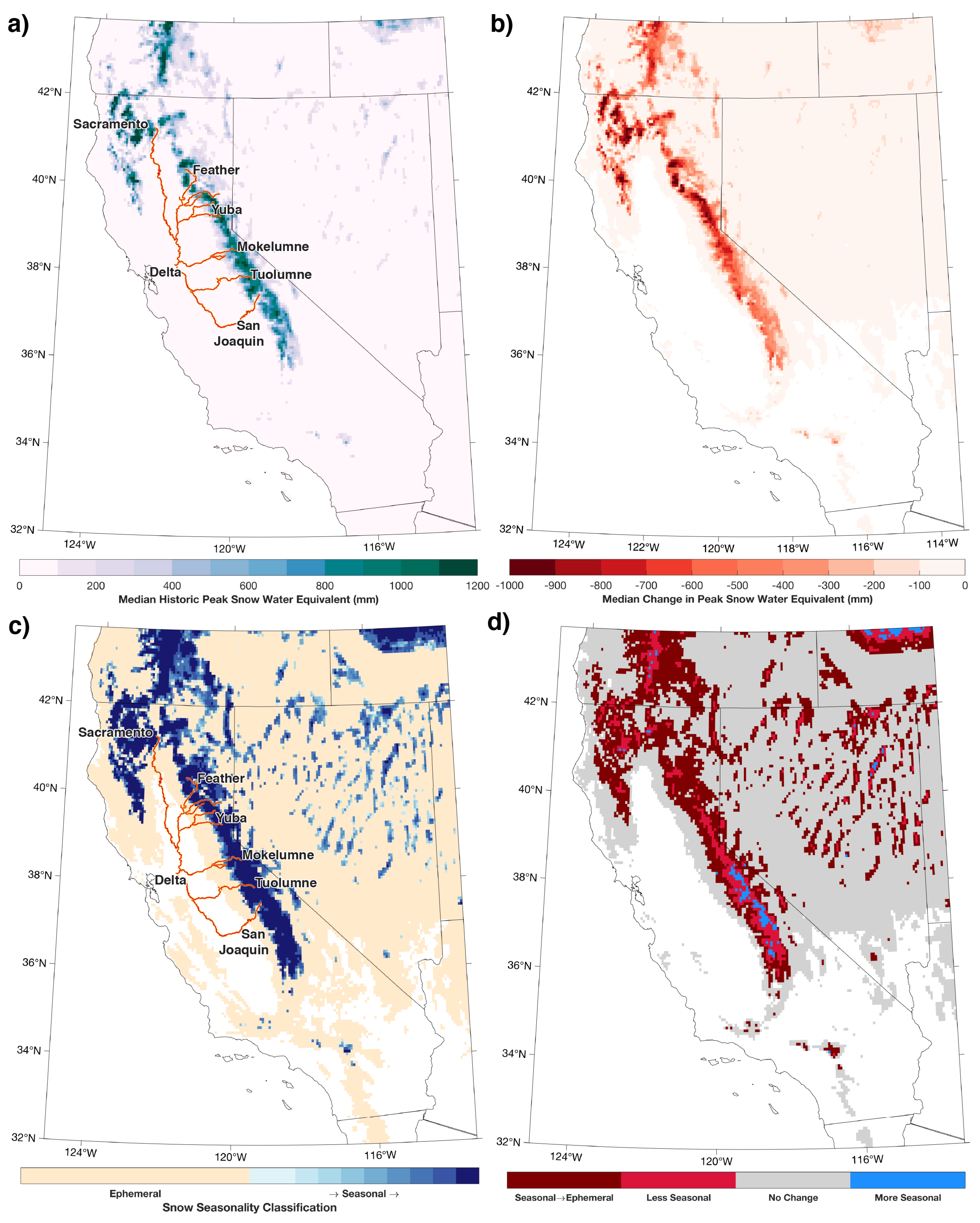

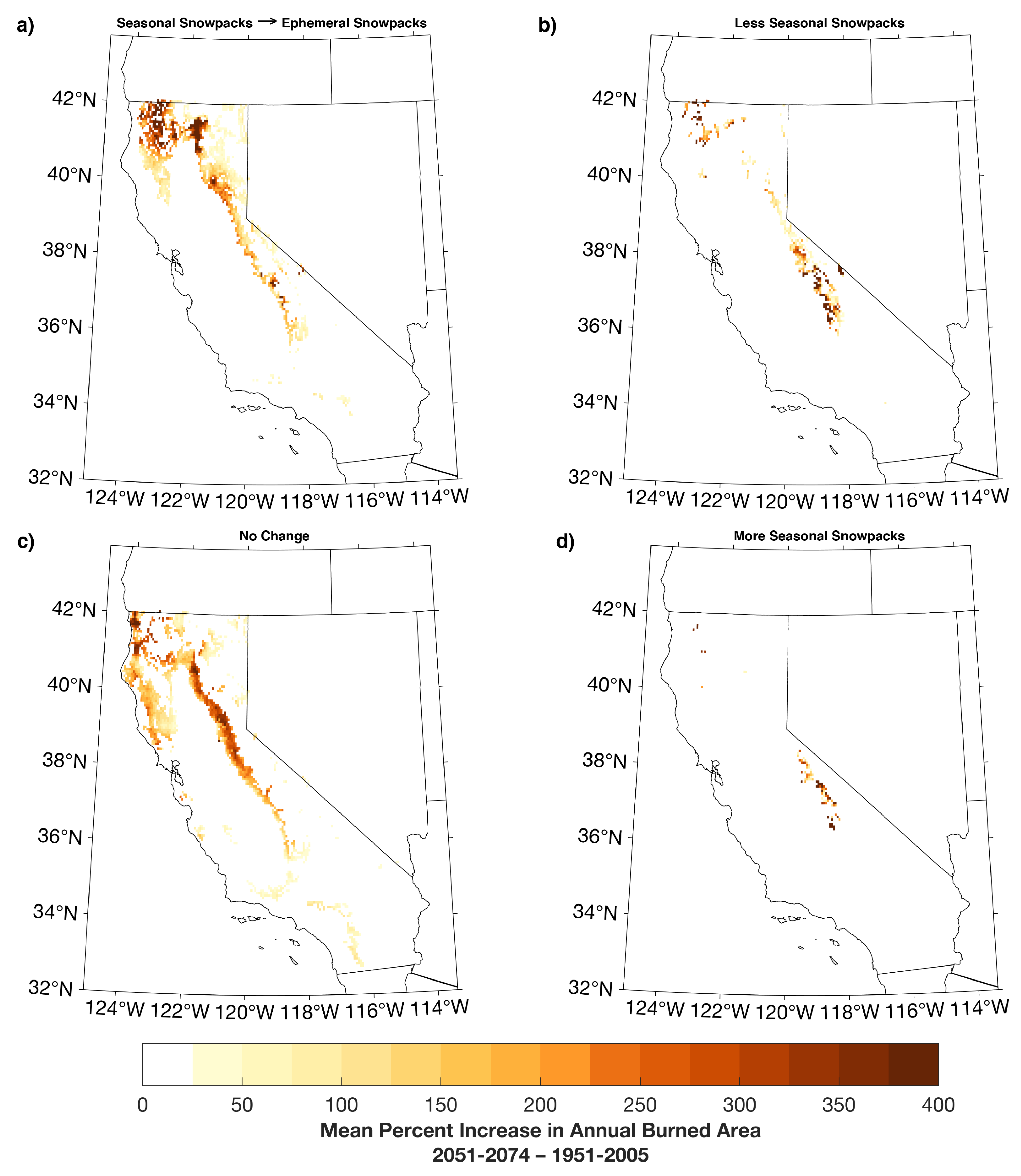
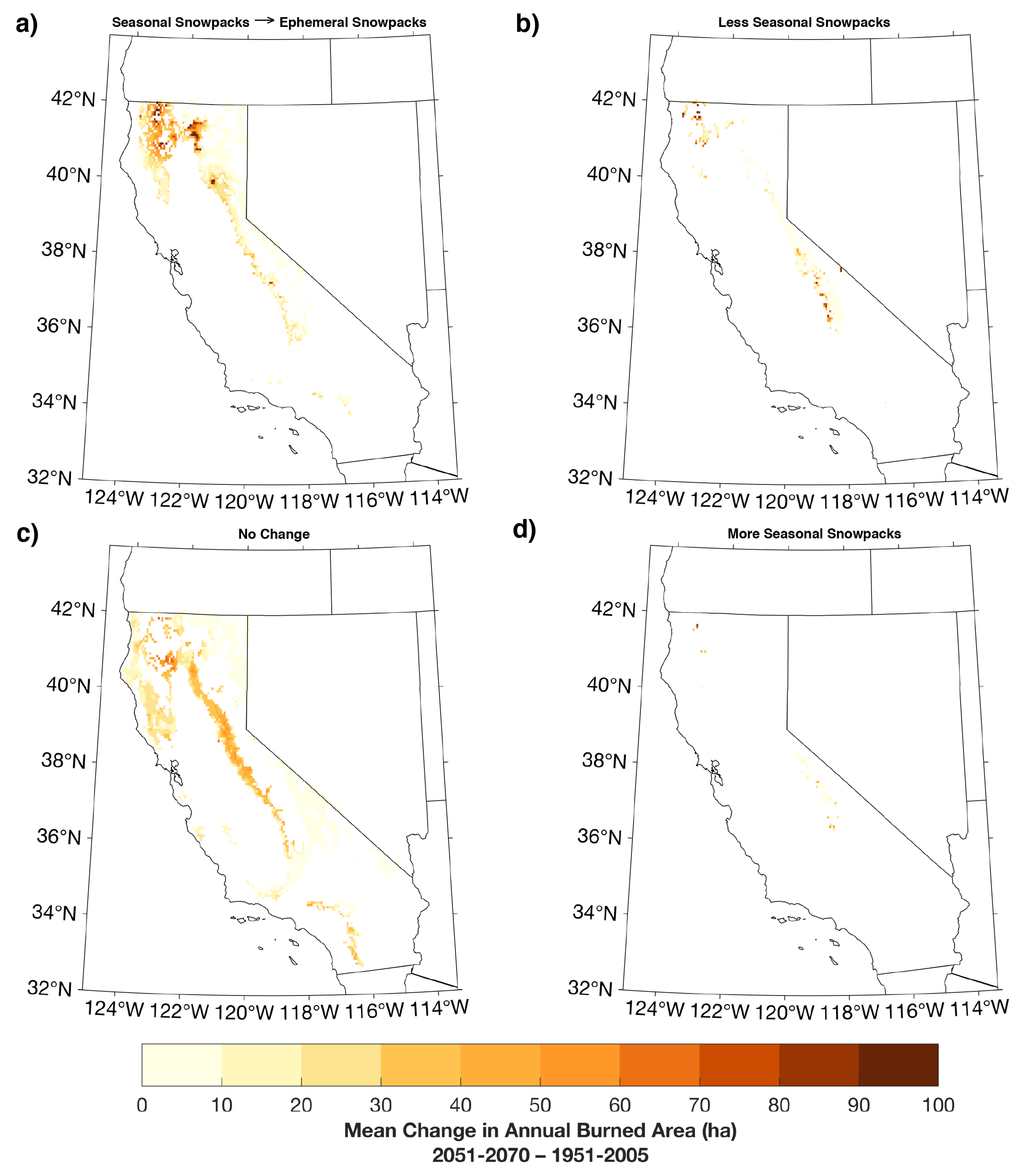
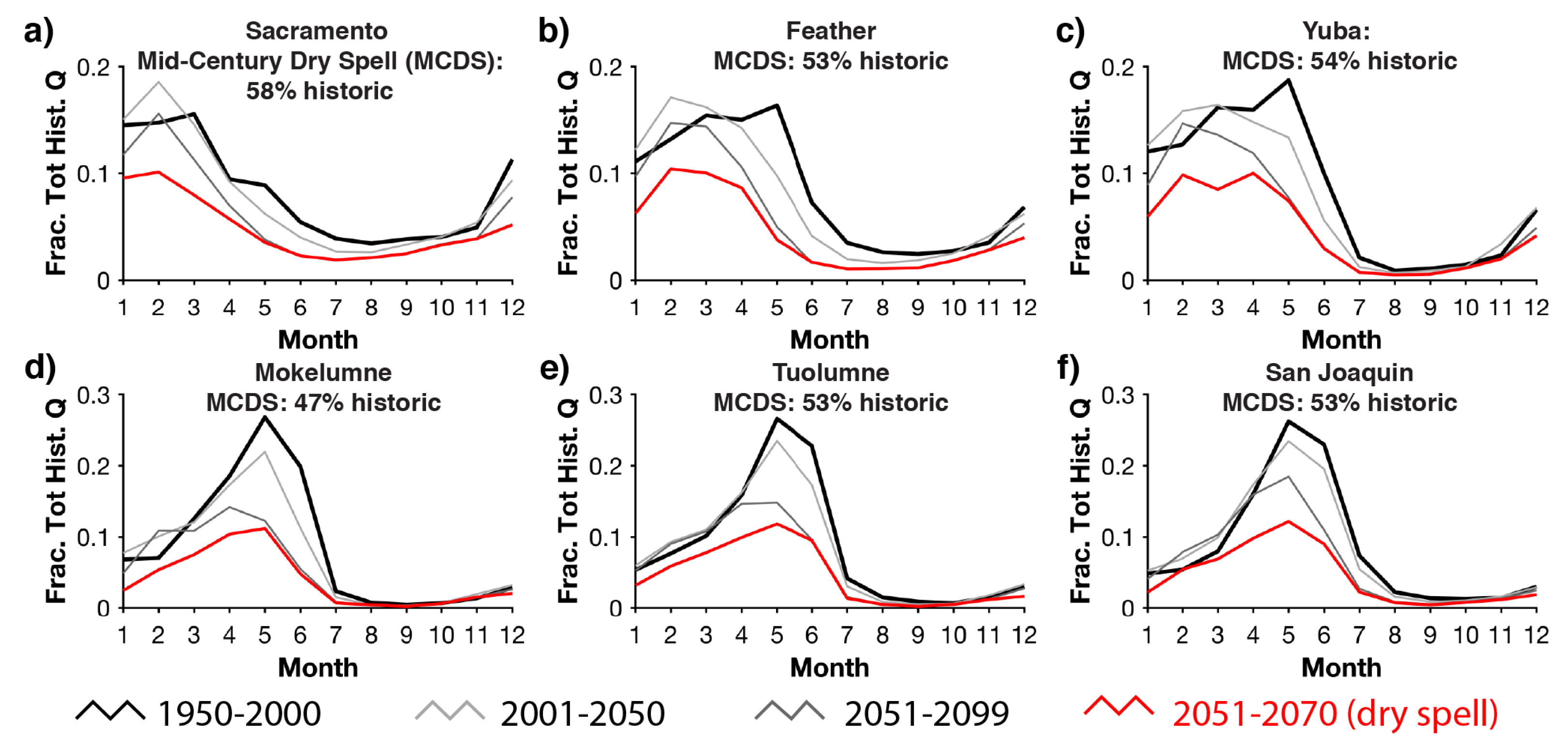
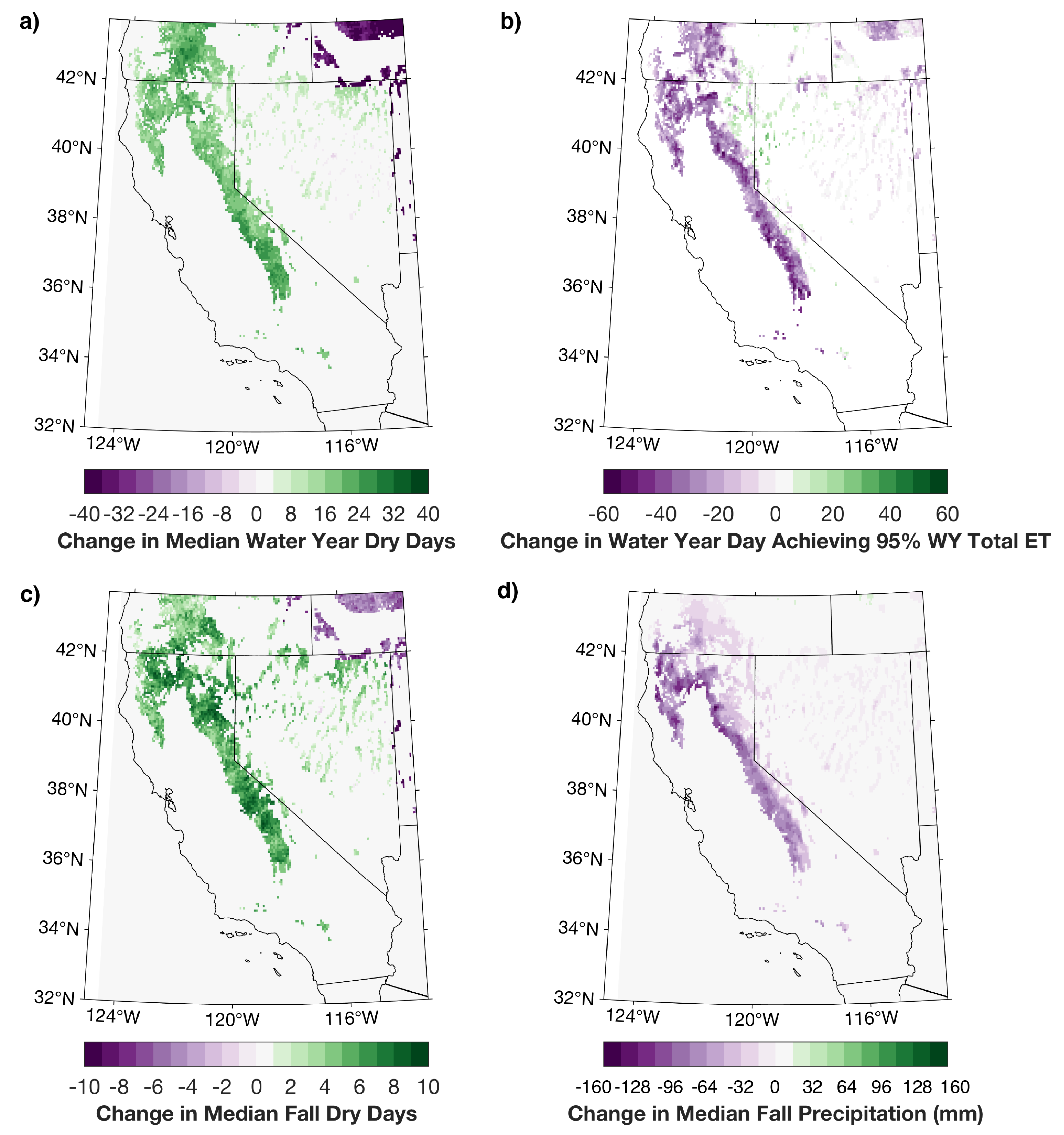
Publisher’s Note: MDPI stays neutral with regard to jurisdictional claims in published maps and institutional affiliations. |
© 2022 by the authors. Licensee MDPI, Basel, Switzerland. This article is an open access article distributed under the terms and conditions of the Creative Commons Attribution (CC BY) license (https://creativecommons.org/licenses/by/4.0/).
Share and Cite
Hatchett, B.J.; Rhoades, A.M.; McEvoy, D.J. Decline in Seasonal Snow during a Projected 20-Year Dry Spell. Hydrology 2022, 9, 155. https://doi.org/10.3390/hydrology9090155
Hatchett BJ, Rhoades AM, McEvoy DJ. Decline in Seasonal Snow during a Projected 20-Year Dry Spell. Hydrology. 2022; 9(9):155. https://doi.org/10.3390/hydrology9090155
Chicago/Turabian StyleHatchett, Benjamin J., Alan M. Rhoades, and Daniel J. McEvoy. 2022. "Decline in Seasonal Snow during a Projected 20-Year Dry Spell" Hydrology 9, no. 9: 155. https://doi.org/10.3390/hydrology9090155
APA StyleHatchett, B. J., Rhoades, A. M., & McEvoy, D. J. (2022). Decline in Seasonal Snow during a Projected 20-Year Dry Spell. Hydrology, 9(9), 155. https://doi.org/10.3390/hydrology9090155





